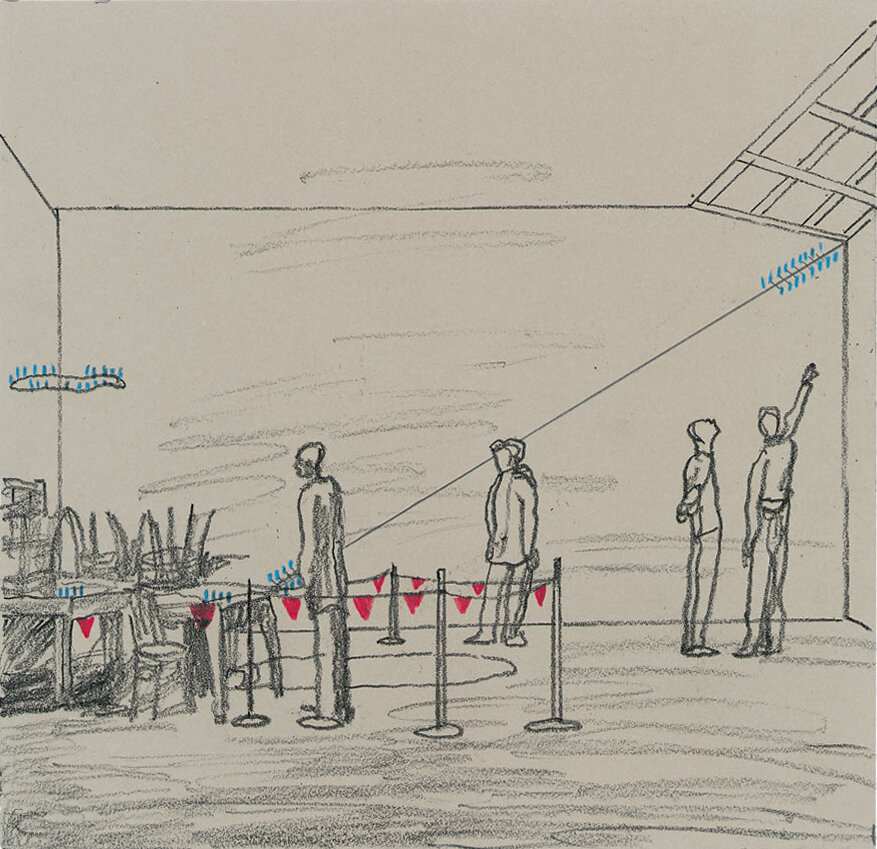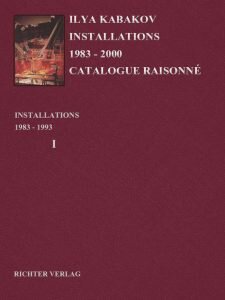Old Furniture and Little White Men
YEAR: 1989
CATALOGUE NUMBER: 24
PROVENANCE
The artist
Collection of the artist
XHIBITIONS
Paris, Galerie de France
Ilya Kabakov. Que sont ces petits hommes? 19 Jan 1989 — 4 Mar 1989
DESCRIPTION
An enormous quantity of old furniture is placed and tossed about the gallery: tables, chairs, cabinets, wall-units … There is a large white spot on the floor with some white paint that has been knocked over. The floor is covered in this place with old cardboard. In every way, the appearance is temporary, muddled, chaotic.
Upon approaching this heap, the viewer notices that in many places – on the corners of the tables, on the seats of the chairs, and even on the floor – there are lots of ‘little white men’: white, flat, paper figures about 2 centimeters tall. Such little white men can also be seen if you lift your head, as they are exiting in pairs toward the upper corner of the gallery not far from the exit. The entire territory of the installation is surrounded by a rope with little flags.
CONCEPT OF THE INSTALLATION
The idea of the installation is connected with the notion of special ‘zones,’ territories, and places where something extraordinary, strange, and unusual has occurred or is occurring. It’s like having police ribbons surround the places where some incident occurred on the street, or where there are dangerous holes or repairs going on. It is as though the small red flags surrounding the installation are to mobilize and warn the viewer that ‘not everything’ is alright here. And in fact, where did these little white men come from and what are they doing here, what is going on? The whole thing is that this entire chaotic, messy heap of furniture is arranged in the corner of a very clean and bright gallery (Galerie de France), and itself serves as a strange contrast to the surrounding space. But of course, dragging junk and chaos into clean exhibition spaces has been practiced for many years now and there is nothing special about it. Therefore, I wanted to magnify, multiply the ‘strangeness,’ so that not only the heap of furniture would be strange, but so would the white men sitting all over it. I wanted the viewer to think for himself and mobilize his own imagination to answer this question: “Why are they here?” I wanted the installation itself to cross over from everyday reality to some new dimension.
Of course, I wanted to convey the idea that everything moves, has lost its foundation, has been swept from its place. Before the viewer is either part of a warehouse or a room where everything has been temporarily heaped together. It is, in general, a sort of destruction of everyday reality, of the domestic order that had previously existed. Parallel to this, the ‘spirits of the place’ (Geist des Ortes) expressed in these little white figures are running away, disappearing.
We, the viewers, somehow see what is usually hidden from us in our everyday life. In our everyday life, we don’t see this or even suspect its existence. But at extreme moments, at moments of crisis and catastrophe, what has concealed escapes to the surface and then, having spent some time before our eyes, also quickly disappear again. This is the same kind of thing that occurs when you are walking in the woods and you turn over a rock and right underneath it, you see all the multitude of beetles, ants, grubs buried from the world above, and you are seized by a state of awkwardness and danger. This is why I decided to cordon off this installation with a rope.
One funny incident was connected with this installation. No matter what happened, I wanted to bring old, dilapidated furniture from my Moscow studio. But when I brought it from Moscow to the gallery in Paris, it turned out that the exact same kind of junk could be found at the markets there and even in the basement of the gallery itself – mediocre bourgeois design is universal and identical all over the world.
Images
Literature




